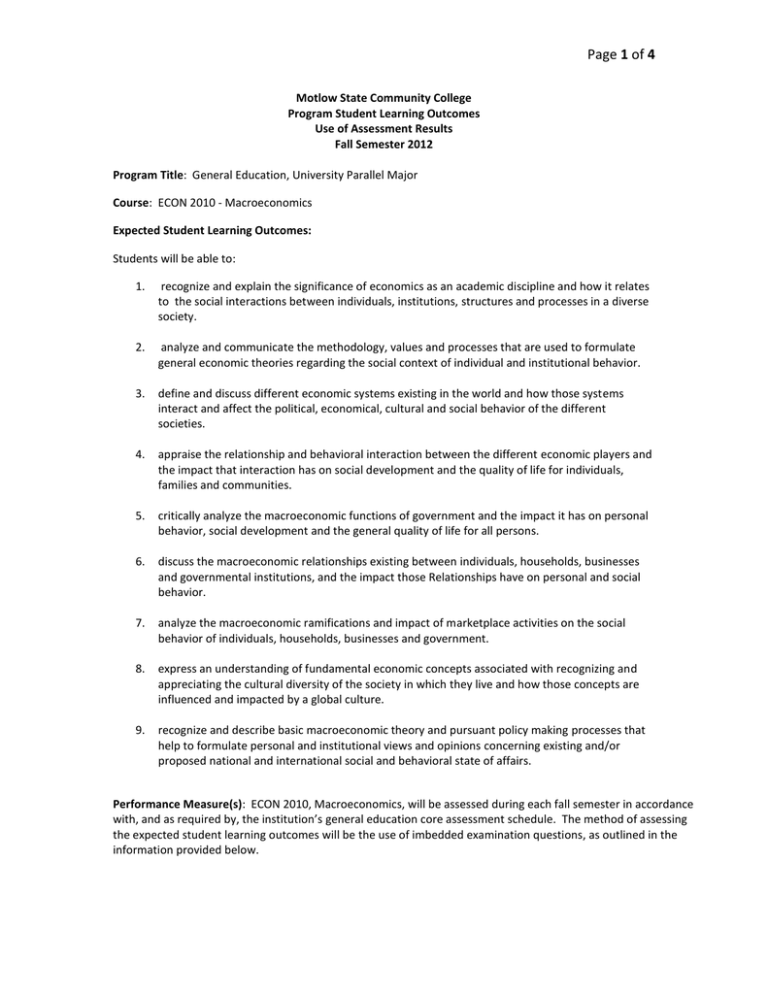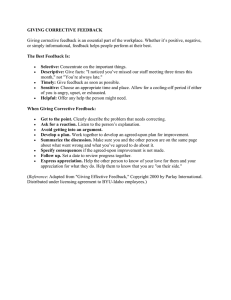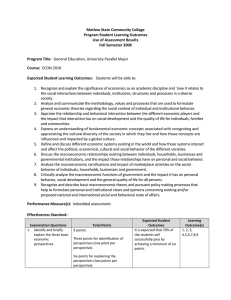1
advertisement

Page 1 of 4 Motlow State Community College Program Student Learning Outcomes Use of Assessment Results Fall Semester 2012 Program Title: General Education, University Parallel Major Course: ECON 2010 - Macroeconomics Expected Student Learning Outcomes: Students will be able to: 1. recognize and explain the significance of economics as an academic discipline and how it relates to the social interactions between individuals, institutions, structures and processes in a diverse society. 2. analyze and communicate the methodology, values and processes that are used to formulate general economic theories regarding the social context of individual and institutional behavior. 3. define and discuss different economic systems existing in the world and how those systems interact and affect the political, economical, cultural and social behavior of the different societies. 4. appraise the relationship and behavioral interaction between the different economic players and the impact that interaction has on social development and the quality of life for individuals, families and communities. 5. critically analyze the macroeconomic functions of government and the impact it has on personal behavior, social development and the general quality of life for all persons. 6. discuss the macroeconomic relationships existing between individuals, households, businesses and governmental institutions, and the impact those Relationships have on personal and social behavior. 7. analyze the macroeconomic ramifications and impact of marketplace activities on the social behavior of individuals, households, businesses and government. 8. express an understanding of fundamental economic concepts associated with recognizing and appreciating the cultural diversity of the society in which they live and how those concepts are influenced and impacted by a global culture. 9. recognize and describe basic macroeconomic theory and pursuant policy making processes that help to formulate personal and institutional views and opinions concerning existing and/or proposed national and international social and behavioral state of affairs. Performance Measure(s): ECON 2010, Macroeconomics, will be assessed during each fall semester in accordance with, and as required by, the institution’s general education core assessment schedule. The method of assessing the expected student learning outcomes will be the use of imbedded examination questions, as outlined in the information provided below. Page 2 of 4 ECON 2010, Macroeconomics Imbedded Examination Questions 1. Identify and briefly explain the three basic economic perspectives. 2. Define “capitalism,” and identify and explain the characteristics of a “capitalist” system. Total Points 9 points. Three points for identification of perspectives (one point per perspective). Six points for explaining the perspectives (two points per perspective). 12 points. Two points for defining “capitalism.” Expected Student Outcomes Student Learning Outcomes It is expected that 70% of all students will successfully pass by achieving a minimum of six points. 1, 2, 3, 4,5,6,7,8,9 It is expected that 70% of all students will successfully pass by achieving a minimum of eight points. 1,2,3,4,5,6,7,8,9 It is expected that 70% of all students will successfully pass by achieving a minimum of ten points. 1,2,3,4,5,6,7,8,9 It is expected that 70% of all students will successfully pass by achieving a minimum of four points. 1,2,3,4,5,6,7,8,9 It is expected that 70% of all students will successfully pass by achieving a minimum of four points. 1,2,3,4,5,6,7,8,9 Five points for identifying the characteristics of a “capitalist” system. 3. Define the business cycle, identify the phases of the business cycle, and explain what is happening to the economic criterion/indicators during each phase of the cycle. (Note: The economic criterion/indicators taught in class should be demand/spending; supply/output; incomes; employment/unemployment; and prices.) 4. Assume that the economy is in the midst of a severe recession. What Fiscal Policy would you recommend and explain the impact it would have on the economy. 5. Assume that the economy is suffering from massive inflation and you are the Chairperson of the FED. What monetary policy/tool would you employ and then using the “cause-effect chain,” explain the effect it would have on the economy. Five points for explaining the characteristics of a “capitalist” system. 14 points. Two points for defining the business cycle. Two points for identifying the phases of the business cycle (four phases, .5 points per phase). Ten points for explaining what is happening to the economic criterion/indicators during each phase (.5 points for each criterion/indicator for each phase). Six points. Three points for selecting the correct Fiscal Policy action. Three points for correctly explaining the economic impact. 6 points. Three points for selecting the correct monetary policy/tool. Three points for correctly explaining the economic impact of the policy/tool using “cause-effect chain.” Page 3 of 4 The Chair of the Business and Technology Department will compile the data and prepare a report concerning the results of the assessment based on the designated Student Learning Outcomes. The report will be prepared and submitted as prescribed by the Director of Institutional Research, Planning and Communication. Effectiveness Standard: Reference the expected student outcomes identified in the aforementioned information. Assessment Results: Fall 2012 Questions Sections L01 Passed/Failed L03, B01, F05, M05 (ITV) Passed/Failed L05, F01, M01 (ITV) Passed/Failed L07, F03, M03, S05 (ITV) Passes/Failed S01 Passed/Failed S03 Passed/Failed 1 20/5 49/5 43/4 21/8 24/11 24/10 Analysis of Assessment Results for Question #1: A total of 224 students completed Question #1; 181 passed/43 failed for an overall passage rate of 80.80%. The overall expected student outcome of 70% was achieved. Corrective Action: No corrective action required. 2 18/7 44/9 39/7 20/7 23/10 24/10 Analysis of Assessment Results for Question #2: A total of 218 students completed Question #2; 168 passed/50 failed for an overall passage rate of 77.06%. The overall expected student outcome of 70% was achieved. Corrective Action: No corrective action required. 3 21/3 40/12 35/10 14/11 15/9 14/9 Analysis of Assessment Results for Question #3: A total of 193 students completed Question #3; 139 passed/54 failed for an overall passage rate of 72.02 %. The overall expected student outcome of 70% was achieved. Corrective Action: No corrective action required. 4 19/5 43/9 38/7 16/6 18/8 17/6 Analysis of Assessment Results for Question #4: A total of 192 students completed Question #4; 151 passed/41 failed for an overall passage rate of 78.65%. The overall expected student outcome of 70% was achieved. Corrective Action: No overall corrective action required. 5 20/3 45/5 39/6 12/11 10/10 11/10 Analysis of Assessment Results for Question #5: A total of 182 students completed Question #5; 137 passed/45 failed for an overall passage rate of 75.27%. The overall expected student outcome of 70% was achieved. Corrective Action: No corrective action required. Use of Assessment Results: As described under Assessment Results, the Performance Measures for the Expected Student Outcomes have been met and the overall Program Learning Student Outcomes for the General Education course Economics 2010, Macroeconomics, have been achieved. As part of the appraisal process, the Economics faculty met and completed an evaluation of the assessment results. Based on that evaluation, the following actions were concluded and affirmed. 1. All questions were reviewed and confirmed to be valid and pertinent to the study of Macroeconomics. Page 4 of 4 2. Instructors will increase efforts to accentuate the instructional content and material associated with the assessment questions. 3. Instructors will strengthen and give increased emphasis to the review of instructional material. 4. Instructors will expand course outlines to more intently focus on the content to be covered during the course. 5. As appropriate and applicable, instructional notes and handouts will be provided in a more timely manner.



